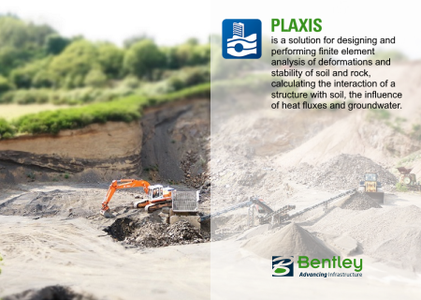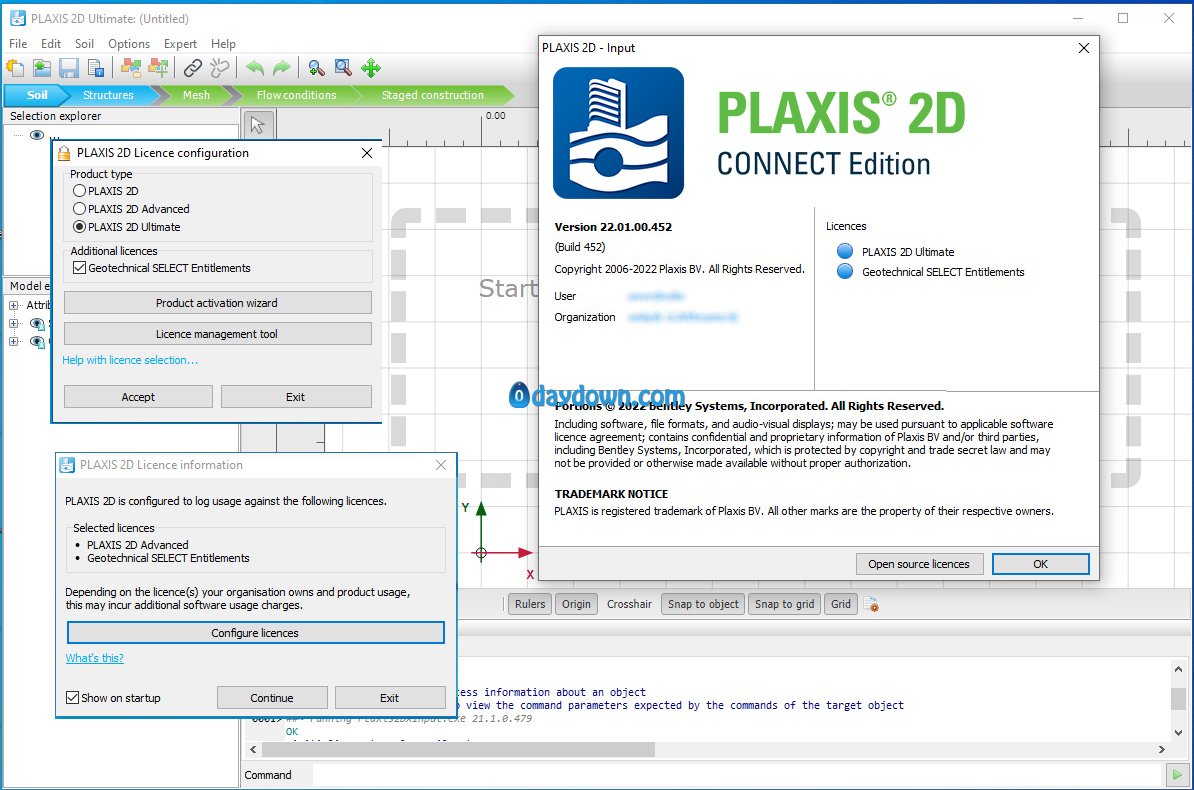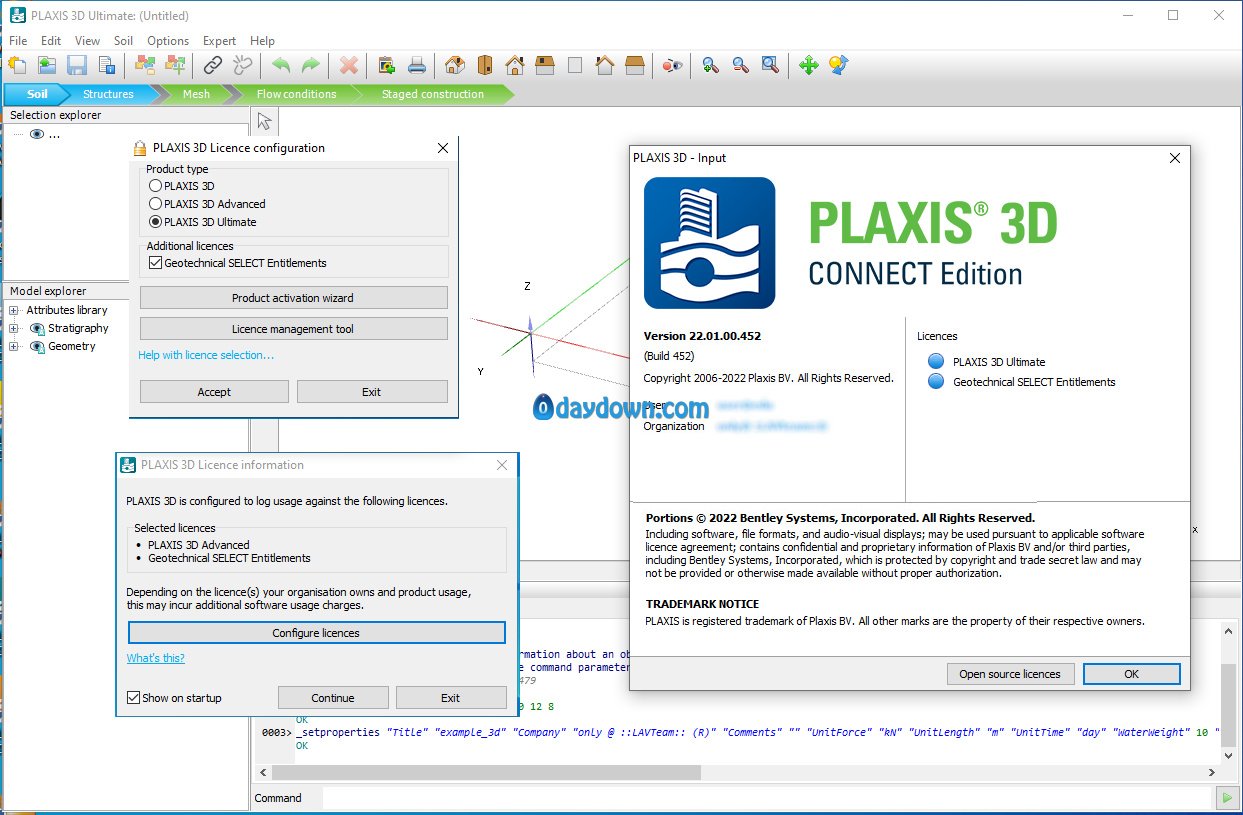
The PLAXIS development team is pleased to announce the availability of PLAXIS 2D/3D CONNECT Edition V22 Update 1. In this latest minor release introduce the discontinuity element in PLAXIS 3D, improved scripting support, did some CAD import improvements and improved troubleshooting when working with Design Approaches.
The sections below will highlight the notable changes and advantages that these releases will bring to users.
Release compatibility when upgrading from V21
Since PLAXIS V22 Update 1 also contains the new data structure of the material database and the more flexible and more robust way of handling project units introduced in the previous release, similar precautions apply with respect to V21 release compatibility. PLAXIS V22 Update 1 will be installed alongside PLAXIS V21, instead of overwriting it. Calculated V21 projects opened with this latest release will automatically be saved as a converted copy with the _converted suffix. After the conversion, remeshing and recalculation are required. In this case, the original V21 project will remain unchanged. For V21 projects that only have their geometry and/or some material sets defined and may be either meshed or not, these projects will be opened by V22 Update 1 without converting to a saved copy. The original V21 project would be overwritten upon saving.
The known issue that caused the assignment of the material factor labels to the material models parameters to be lost, when a V21 project containing Design Approaches is opened with V22 is now fixed in the latest release.
Note that these converted projects are stored in the file format for PLAXIS V22 Update 1, this means that earlier versions of PLAXIS will not be able to open the converted project files. To continue using V21, users can just open the original V21 project.
Discontinuity element
Rock is not a homogeneous material: the presence of faults, fractures, joints, and weakness planes influence the mechanical behaviour, often more than the properties of the rock material itself.
In PLAXIS, constitutive models such as Jointed Rock and Hoek-Brown capture the behavior of small, smeared discontinuities, while the larger explicit discontinuities have traditionally been modeled through Interface elements. The new Discontinuity element, initially introduced for PLAXIS 2D in Version 22, enables a simpler modeling workflow. This element is now also made available for PLAXIS 3D in V22 Update 1.
Discontinuity elements simulate the localized effects of discontinuities in rock, including opening/closing and sliding. Discontinuities decouple the nodes in the mesh, enabling the relative displacement between the two faces of the opening, which are linked by a set of independent springs for which normal (kn) and shear (ks) stiffnesses can be specified. The mechanical properties of Discontinuities are defined through their own material sets, instead of depending on the surrounding material, which makes them easier to use and to port from project to project.
Discontinuities in PLAXIS 3D
CAD Improvement – importing polycurves as polygons
In PLAXIS 2D, geometry from CAD files is typically imported the same way as it is defined in the CAD file. This means that polylines, whether closed or open, will normally be imported as polylines and lines as lines etc. However, in CAD drawings the closed polylines usually represent soil/rock clusters or structures like quay walls etc. and users will expect these to be recognized by PLAXIS as soil/rock/structure polygons. This goes very well when users assigned so called Regions or Boundaries to their CAD drawing before exporting it from their drawing tool.
However not every software, for example Leapfrog, supports the creation of Regions or Boundaries, therefore importing CAD drawings that contain closed polylines into PLAXIS 2D would sometimes require the user to manually trace the imported polylines to create polygons.
In this latest release the interoperability with CAD packages becomes much easier and more robust better by introducing the “Import closed polylines as polygons” option in the import window. When activating this option in the import window, the GUI will show all the polygons that will be created and once accepted, the only thing left to do for the user is to assign the materials to the automatically created soil/rock polygons.
Design Approaches feedback details in PLAXIS 2D
When editing soil materials in the Materials window, the side panel will now give warnings and errors about potentially invalid parameter combinations when combined with a created Design Approach and its applied material factors. In addition, the validate <material> command has been extended to include the feedback for the potentially invalid parameter combinations when combined with a created Design Approach.
Design Approaches command feedback details in PLAXIS 2D
The pre-calculation checks have also been improved and now give a better indication of the phase, material and the Design Approach that cause an invalid material set that blocks the calculation. This information is also available through scripting (validate and checkcalculationconditions) allowing users to ensure their applied Design Approaches are valid when generating models through scripts, before launching the calculation.
Calculation warnings on Design Approaches in PLAXIS 2D
Command for Cross-section results
When creating a line or planar cross-section in PLAXIS 2D or 3D, all the results for the created cross-section are stored in tables accessible through the GUI, but for scripting these results were not available. Users had to manually loop over coordinates that would outline a cross-section to retrieve the relevant result. With the new getcrosssectionresults command it’s much easier, as users can now directly retrieve results from created cross-sections and access the results that are stored in the cross-section table.
PLAXIS 2D is a powerful and user friendly finite element package intended for two-dimensional analysis of deformation and stability in geotechnical engineering and rock mechanics. PLAXIS is used worldwide by top engineering companies and institutions in the civil and geotechnical engineering industry. Applications range from excavations, embankment and foundations to tunnelling, mining and reservoir geomechanics.
PLAXIS is equipped with a broad range of advanced features to model a diverse range of geotechnical problems, all from within a single integrated software package.
PLAXIS uses predefined structural elements and loading types in a CAD-like environment. This empowers the user with fast and efficient model creation, allowing more time to interpret the results.
PLAXIS 3D is a powerful and user friendly finite element package intended for three-dimensional analysis of deformation and stability in geotechnical engineering and rock mechanics. PLAXIS is used worldwide by top engineering companies and institutions in the civil and geotechnical engineering industry. Applications range from excavations, embankments and foundations to tunnelling, mining and reservoir geomechanics.
PLAXIS 3D has advanced features to tackle modelling challenges in the most complex geotechnical projects, that cannot be solved with PLAXIS 2D.
Finite element modelling in full 3D has never been easier with a range of CAD-like drawing tools and extrude, intersect, combine and array operations. It’s almost like sculpting.
Bentley Systems is a software development company that supports the professional needs of those responsible for creating and managing the world’s infrastructure.


Product: PLAXIS
Version: 2D/3D CONNECT Edition V22 Update 1 (22.01.00.452)
Supported Architectures: x64
Website Home Page : http://www.plaxis.com
Languages Supported: english
System Requirements: Windows *
Size: 4.5 Gb
Password/解压密码www.tbtos.com